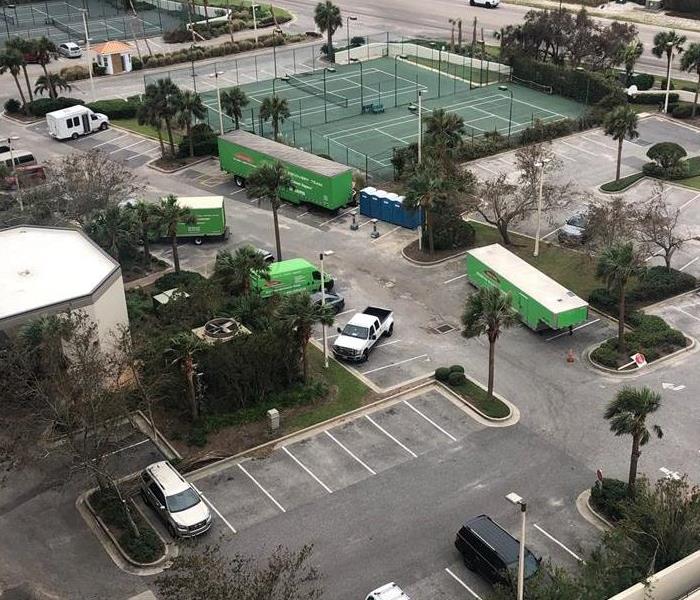Archived Storm Damage Blog Posts
Everything You Need to Know About Frozen Pipes
1/7/2023 (Permalink)
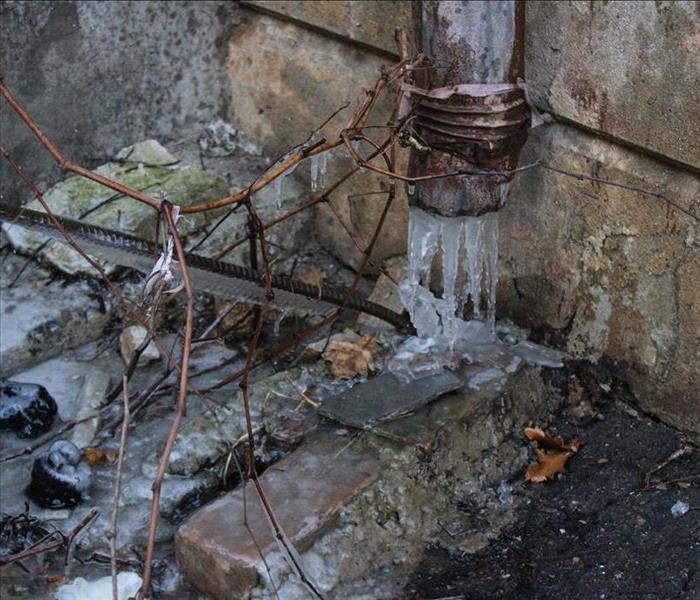 Pipes can freeze in the event that temperatures drop below 20 degrees Fahrenheit.
Pipes can freeze in the event that temperatures drop below 20 degrees Fahrenheit.
Winter weather, as appealing as it may be to the eye, poses its fair share of serious property damage risks. Regardless of how much damage winter weather causes, SERVPRO Team Wall is always ready, standing by with the resources, experience, and expert knowledge to restore your commercial property to its preloss condition. This blog will discuss one specific, cold weather issue that commercial properties frequently face: frozen pipes. We will also share tips from the American Red Cross about ways in which you can protect your property from the water damage and property damage that can result from burst frozen pipes.
Prime Conditions
Pipes can freeze in the event that temperatures drop below 20 degrees Fahrenheit. Uninsulated pipes located outdoors or in unheated areas of your business can be at increased risk of bursting. Pipes in basements and crawl spaces are at especially at risk of freezing. When temperatures get cold, be sure to look for signs of freezing, like frost or no water coming out of your faucets.
Preventing Frozen Pipes
According to the American Red Cross, there are a few different ways to prevent pipes from freezing when temperatures drop. Letting water drip through your faucets periodically is one such suggestion. They also suggest adding insulation to pipes in unheated areas. This will help maintain a safe temperature for the pipes. In heated areas of your property, consider keeping your nighttime thermostat temperature and your daytime temperature the same. While lowering temperatures at night can save money, maintaining a steady indoor temperature can help keep your pipes warm enough to prevent them from freezing.
Dealing With Burst Pipes? Call SERVPRO Team Wall
In the event that your commercial property’s pipes freeze and burst, SERVPRO Team Wall is standing by with our expert storm and water damage restoration team and our cutting-edge equipment. To learn more about our commercial water and storm damage restoration capabilities, visit our website. The moment you discover frozen or burst pipes in your commercial property, immediately call your local SERVPRO Team Wall office, SERVPRO of Harrisburg West, at (717) 510-6779. Breathe a sigh of relief and trust SERVPRO Team Wall to make it “Like it never even happened.”
A Recap of Florida's Hurricanes and Hurricane Season 2022
11/20/2022 (Permalink)
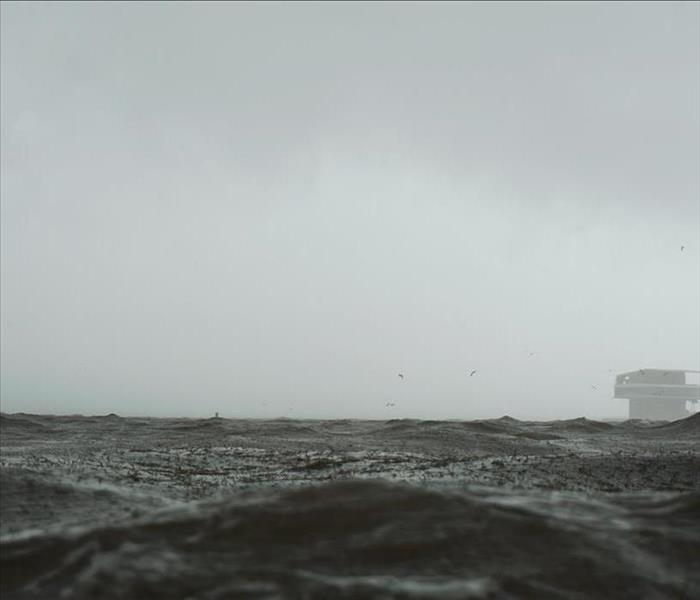 Strong storms, like hurricanes, can impact your area at any time during hurricane season, hurricanes can even make landfall as late as November.
Strong storms, like hurricanes, can impact your area at any time during hurricane season, hurricanes can even make landfall as late as November.
The end of this year’s Atlantic hurricane season left its mark on Florida, as both Hurricane Ian and Hurricane Nicole impacted Florida communities. SERVPRO Team Wall and our Disaster Recovery Team had the opportunity to serve affected communities in Florida. Hurricane Ian and Hurricane Nicole made landfall in Florida within a relatively short time of each other, wreaking havoc on residential and commercial properties alike. To learn more about where Florida’s 2022 hurricanes fit in the grand scheme of the Atlantic hurricane season, continue reading.
Florida Hurricanes 2022
Upon making landfall in Southwest Florida in mid-September, Hurricane Ian resulted in a devastating number of casualties, left many without power, and caused significant damage to properties. Only 43 days later, another hurricane, Nicole, hit many of the same Florida areas without power once and sending first responders on search and rescue missions. The hurricane double-whammy of Ian and Nicole may appear to be an anomaly, but something similar happened in 2004. 18 years ago, Hurricanes Charley and Jeanne, which both made landfall in Florida in 2004, impacted almost the same areas of the state as Ian and Nicole. Additionally, the same amount of time lapsed in between the two storms. Considering this information, what can property owners in Florida and across the country learn from this information?
Call SERVPRO with Any Storm Emergency
Strong storms, like hurricanes, can impact your area at any time during hurricane season, hurricanes can even make landfall as late as November. As we have seen in the case of Hurricane Nicole, a November hurricane isn’t a rare occurrence. Rather, it is a very real possibility, especially for coastal states like Florida. In the event of any emergency, call SERVPRO of Harrisburg West at (717) 510-6779 for professional Storm Damage Restoration services. We also offer storm damage restoration services tailored to commercial properties, perfect for commercial businesses. Our website also includes information about our other storm-related offerings, such as our Large Loss Disaster Recovery Team that aids communities following strong storm events such as hurricanes, as well as our residential and commercial Water Damage Restoration services. You can count on SERVPRO Team Wall to make it “Like it never even happened” after any emergency.
3 Types of Lightning in a Storm
9/23/2022 (Permalink)
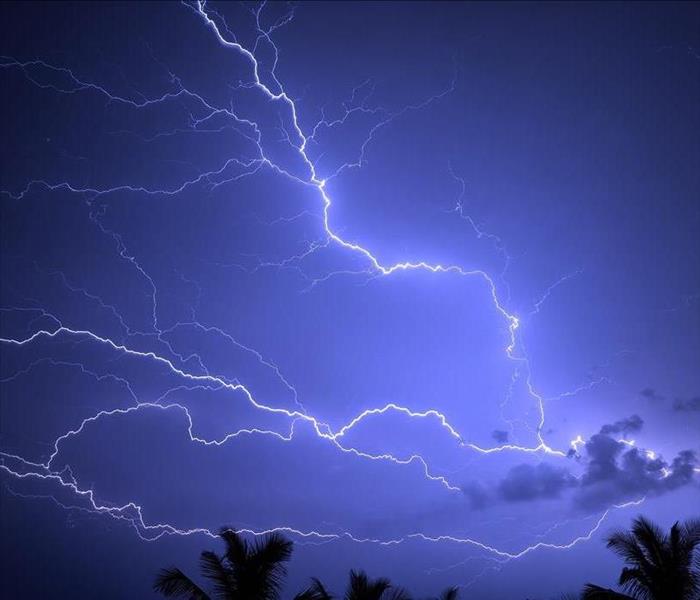 Becoming familiar with these 3 different types of lightning is an important part of storm safety.
Becoming familiar with these 3 different types of lightning is an important part of storm safety.
Nearly every storm event presents lightning and, with it, serious concerns for human safety. All the while, lightning also poses risks to residential and commercial properties. Hurricanes, which we do not often consider to be storms capable of producing lightning, do sometimes have lightning near the eye of the storm. During a thunderstorm, there are 3 common types of lightning you may see. Becoming familiar with these 3 different types is an important part of storm safety. Today’s blog will explain the 3 common types using information from NOAA’s “Lightning Types” article, but we will also discuss safety risks associated with each lightning type so that you can be informed, which is the best way to protect yourself and your home or business from lightning dangers.
Cloud-to-Ground Lightning
Cloud-to-ground lighting is the most dangerous type of lightning for properties. This type of lightning occurs when a channel of negative charge shooting down from a storm cloud meets a positive charge from tall objects like nearby trees, power lines, and tall structures like homes and commercial buildings. In the event that the positive charge comes from a tall property, the unification of the positive and negative charges causes an electrical current to start flowing, posing safety risks to properties and people inside of them if a fire ignites as a result of an electrical surge. To prevent damage from a lightning strike, it is best to protect your property with surge protectors. If a thunderstorm is in your area, even if you don’t see lightning, it is beneficial to step away from electrical appliances and avoid activities involving water, such as taking a shower or washing dishes.
Cloud Flashes
From time to time, lightning never reaches the ground. When you see flashes of light in the clouds but no lightning bolts, what you are observing is known as cloud flashes. In cloud flashes, the lightning usually remains in the clouds through what NOAA calls “intra-cloud lightning flashes.” According to The National Weather Service, “an electrical discharge between oppositely charged areas within the thunderstorm cloud” causes cloud flashes. Even though we know that cloud-to-ground lightning is a more dangerous type of lightning, cloud flashes still pose safety threats, as they indicate that the storm is producing lightning, so cloud-to-ground lightning could develop at any time.
Heat Lightning
It may come as a surprise to learn that there is no such thing as heat lightning. So why are we including it in this blog? The National Weather Service states that if you see cloud flashes without thunder (what we normally call “heat lightning”), what you see is actually faint lightning flashes from a thunderstorm just far enough away that your eyes can’t see the cloud-to-ground lightning it is generating or hear the thunder that accompanies it.
Experience Lightning Damage? Call SERVPRO
If lightning from a storm causes damage to your property, call SERVPRO Team Wall as soon as possible for fast, 24-hour service that will restore your home or business to its preloss condition. With top-of-the-line resources and professional, experienced storm damage restoration specialists, we specialize in making your property damage “like it never even happened” after any storm. At the first sign of damage, pick up the phone and call SERVPRO of Harrisburg West at (717) 510-6779 to speak with one of our team members. Be sure to also check out our website for more information about our Storm Damage Restoration capabilities, including storm restoration services tailored specifically to commercial properties, our Disaster Recovery Team for large losses, and our water restoration process.
Did You Know?: September Is Peak Hurricane Season
9/16/2022 (Permalink)
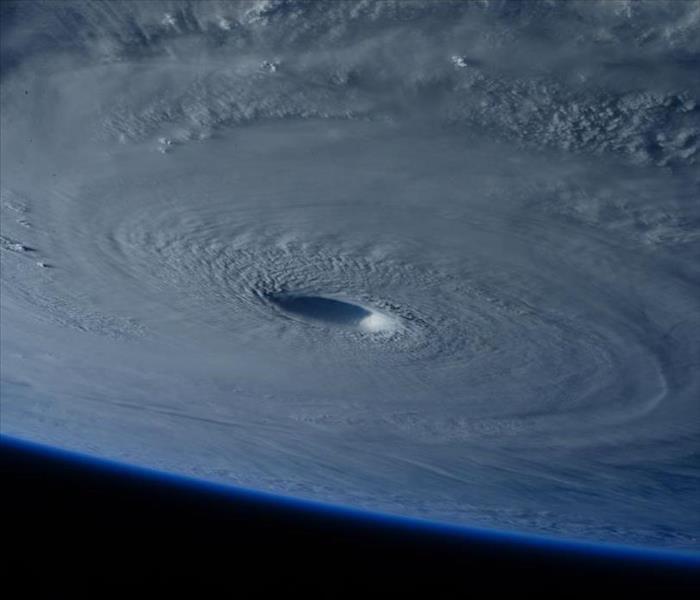 Property owners should continue to take proactive actions to protect their properties even as we enter the last portion of hurricane season.
Property owners should continue to take proactive actions to protect their properties even as we enter the last portion of hurricane season.
An article declaring September as the “annual peak of Atlantic hurricane season” was posted on weather.com just last week. The author, a senior meteorologist at weather.com, explains that September 10th marked the statistical, climatological peak of hurricane season, a time in which “the Atlantic Basin has had the most hurricanes and named storms over the course of history.” Hurricane season in the northern hemisphere begins June 1st and ends November 30th, according to NOAA. As we know, September 10th does not fall exactly in the middle of hurricane season. Therefore, we might ask: what makes September peak hurricane season? In today’s blog, we will answer this question and share options that property owners have when seeking to protect their homes and businesses during peak hurricane season.
What Makes September Peak Hurricane Season?
According to the weather.com article, among the factors that increase the likelihood of hurricanes forming in the Atlantic region during the month of September are “ocean water reaching its highest temperature, the atmosphere's ability to generate thunderstorms hitting its peak, and hostile shearing winds declining to a minimum,” as well as “tropical waves,” which peak in July and carry into September. The author also references statistical data illustrating the peak of hurricanes on or around September 10th. Additionally, the data shows that 77% of named storms and 87% of hurricanes in an average hurricane season occur in August, September, and October. Based on this information, we can deduce that, while we are currently in the most active portion of hurricane season, heightened hurricane prevalence stretches well into the rest of September and October. As a result, residential and commercial property owners should continue to take proactive actions to protect their properties from increased potential storm activity, even as we enter the last part of hurricane season.
Hurricane Preparedness
According to the American Red Cross, property owners should prepare for two primary things before a hurricane: wind and flooding. Cutting back trees and bushes close to your property and securing windows with storm shutters are two steps you can take to protect your property from damaging winds. With regards to flooding prevention, it is imperative that your gutters and drains are cleared before the storm, as this will allow for increased drainage. All the while, hurricanes are powerful forces of nature that can cause unanticipated property damage even when preventative measures are taken in advance. If your residential or commercial property undergoes storm damage in the aftermath of a hurricane this hurricane season, SERVPRO Team Wall has your back. Pick up the phone and call SERVPRO of Harrisburg West at (717) 510-6779 at the first sight of damage. You can also visit our website to learn more about our professional Storm Damage Restoration services, Commercial Storm Damage Restoration, and our experienced Disaster Recovery/Large Loss Team. After any emergency, take solace in knowing that SERVPRO will make it “Like it never even happened”for your residential or commercial property.
What’s the Latest with Hurricane Season?
8/4/2022 (Permalink)
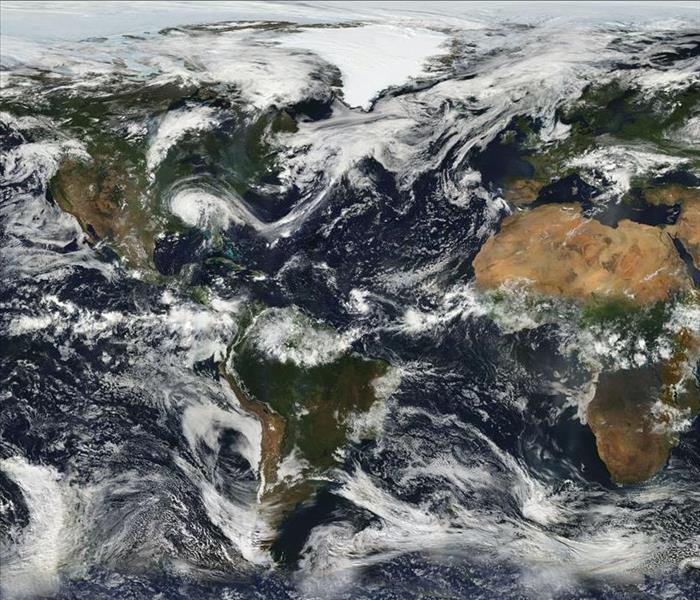 While activity has been low so far, there is still time for hurricane activity to ramp up and produce dangerous storms.
While activity has been low so far, there is still time for hurricane activity to ramp up and produce dangerous storms.
Back in June, hurricane season officially began on June 1st for the Atlantic Ocean in the Northern Hemisphere. NOAA had previously predicted that this year’s hurricane season would be an unusually active one. If you’re scratching your head and wondering why you don’t remember a hurricane so far this summer, your memory is perfectly intact. Earlier this week, The Washington Post published an article investigating the rarity that is the 2022 hurricane season. They reported that this is the first year since 2017 that the Atlantic Ocean hasn’t seen the development of a hurricane prior to August 1st. All this considered, property owners are likely wondering: should we still be preparing for hurricane season or should we just throw in the towel?
There Is Still Time
Even though we are three months into hurricane season, we still have three more months to go, with two of them (August and September) being the peak of hurricane season. While activity has been low so far, there is still time for hurricane activity to ramp up and produce dangerous storms. The bottom line is that, yes, property owners still need to be preparing for the possibility of hurricanes through the end of November, when hurricane season formally ends.
Hurricane Preparedness Tips
With the ever present threat for hurricanes during the remainder of hurricane season in our minds, we would like to take the time to share two of our top hurricane tips with you in today’s blog. These proactive storm tips can help you protect your home or business in the event of storms ranging from a passing afternoon thunderstorm to a hurricane or flood:
- When the weather is nice, check your roof and gutters for damage. Because they’re out of sight, your roof and gutters can be out of mind. However, if shingles get loose or your gutter clogs, your property can be at a greater risk for avoidable damage during a storm. Therefore, when you can do so safely, do your best to inspect your roof and gutter for pre-existing damage. Unclogging your gutters and ensuring that your roof is in good condition prior to a storm are two pivotal steps that you can take in protecting your property.
- Put together a hurricane preparedness kit. When a strong storm like a hurricane hits, a hurricane prep kit is a great resource to have in order to make sure that those occupying your property have necessities in an emergency. To put together your own kit, check out Ready.gov’s “Build A Kit” guide, which includes lists of items that may be beneficial to have in your hurricane prep kit, tailored to families, offices, and your individual needs.
It is impossible to predict exactly how a hurricane or any strong storm will impact your residential or commercial property. However, you can always count on SERVPRO Team Wall to have your back, no matter what. Trust our tight-knit team and experienced crews of storm damage restoration professionals to provide the residential and commercial storm damage restoration services that have made SERVPRO famous for making it “Like it never even happened” for properties near and far. On our website, you can find more information about our water restoration process, in addition to the ways in which we care for your belongings after a storm disaster. Learn more about what we can do to restore your property by giving us a call at (717) 510-6779.
Lightning Hazards for Residential Properties
6/17/2022 (Permalink)
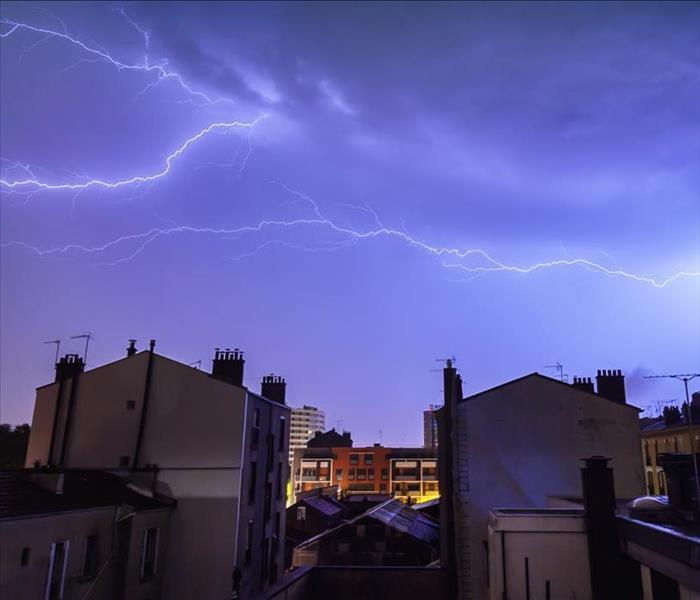 Lightning occurs most frequently during the summer. This means that now is the time to get familiar with indoor lightning safety.
Lightning occurs most frequently during the summer. This means that now is the time to get familiar with indoor lightning safety.
The interiors of residential properties are the location of almost one-third of injuries sustained from lightning strikes, according to The Centers for Disease Control. We’ve all heard the basics of outdoor lightning safety: get out of the pool at the first rumble of thunder, seek shelter immediately, etc. Once you find shelter, however, indoor lightning safety is just as important. Discussing lightning safety this time of year is especially relevant, as lightning is dangerous any time of the year, but lightning occurs most frequently during the summer. This means that now is the time to get familiar with indoor lightning safety in order to protect your home, as well as those living in it.
In the event that lightning strikes a residential structure, it can risk a serious fire hazard. As explained by Weather.gov, “each spark of lightning can reach over five miles in length, soar to temperatures of approximately 50,000 degrees Fahrenheit, and contain 100 million electrical volts.” With this information, it is clear that lightning is powerful enough to ignite dangerous fires in residential structures and the electrical currents sent through homes, resulting from lightning, can risk the safety of those living in the home. Keep reading for additional lightning safety tips that can be practiced in your home.
Keep Your Distance from Electrical Equipment
Lightning, as we’ve learned, can contain 100 million electrical volts, making it imperative that you refrain from using electrical equipment during a thunderstorm, as doing so can facilitate electrical shock or fire. Lightning also travels through electrical currents, like those that are used by radios and televisions, so it is crucial to refrain from using electrical devices that utilize this equipment, like corded landlines. Consider switching to a battery-powered radio or your smartphone in order to stay up to date on weather news during a storm. You may also consider purchasing surge protectors for your home, which work to protect your electrical appliances during storms.
Avoid Plumbing and Water
Think back to every time you’ve been called out of the ocean or the pool during a thunderstorm. Just as it is important to get out of the water when outdoors, avoiding water and plumbing indoors during a storm is recommended. It is important to remember that showering, taking a bath, and even washing the dishes during a thunderstorm can be dangerous, as lightning can travel through a property’s plumbing. Therefore, it is best to refrain from activities that utilize water until the storm passes.
Shelter in the Safest Area Possible
When seeking shelter, be sure to take cover in the safest area of your home. This means avoiding screened-in porches and rooms with windows or doors. Instead, seek shelter in an interior room of the home. It is recommended to keep your distance from concrete floors and walls because lightning can travel through concrete walls and flooring.
Storm Damage Takes You By Surprise? Call SERVPRO
The preventative measures outlined in this blog can help protect your home and those living in it. All the while, storms are powerful, unpredictable, and often dangerous. In the event that your home experiences unexpected storm damage, SERVPRO Team Wall is here to help. Learn more about our various Storm Damage Restoration services and the SERVPRO Disaster Recovery Team by visiting our website. You can also speak with one of our knowledgeable team members by giving us a call at (717) 510-6779. After any disaster, whether it be large or small, we are here to help you make it “Like it never even happened” for your home.
An Overview of Our Full Capacity Storm Damage Restoration
6/16/2022 (Permalink)
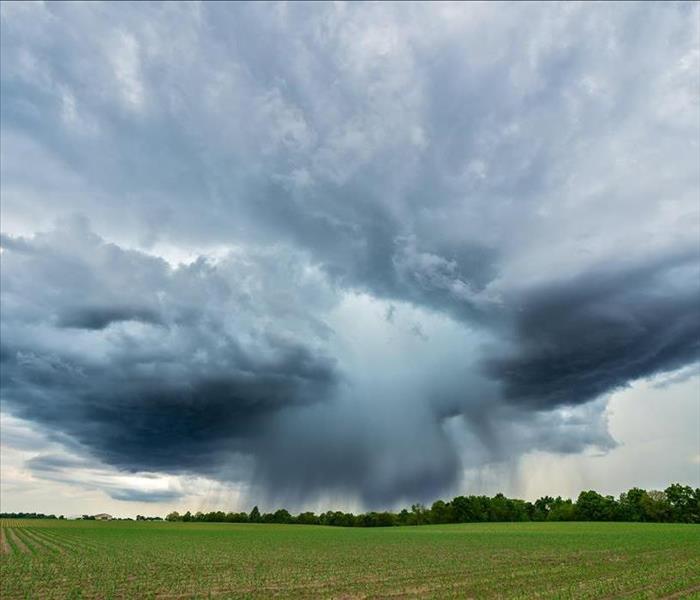 For our storm damage restoration and construction professionals, and our expert techniques and equipment, no job is too large or too small.
For our storm damage restoration and construction professionals, and our expert techniques and equipment, no job is too large or too small.
We mean it when we say, “no matter the disaster,” whether it be under the sun or a storm cloud. For SERVPRO Team Wall, our storm damage restoration and construction professionals, and our expert techniques and equipment, no job is too large or too small. From long storms that leave a trail of damage in their paths or short yet strong storms that wreak havoc on a small area, SERVPRO Team Wall is ready to help make it “Like it never even happened” for your residential or commercial property and standing by 24/7.
Our Services Are Full Capacity
After a storm emergency, you can expect full capacity services when you recruit SERVPRO Team Wall’s help. This means that we are prepared to handle the job from start to finish. Your home or business may require construction work after a severe storm in order to return to its preloss condition and function properly. By offering construction services alongside storm damage restoration, we can simplify the process of restoring your property. With only one qualified company to supervise and carry out every part of the process, you have fewer things to coordinate and worry about, which benefits your peace of mind and keeps costs low. Give us a call at (717) 510-6779 or peruse our website to learn more about our Storm Damage Restoration services, construction capabilities, and Building Services.
Expertise Cultivated Through Experience
Our storm damage restoration experience here at SERVPRO Team Wall does not end with the Mid-Atlantic region. Rather, our team frequently travels across the country to serve our customers near and far. With access to SERVPRO’s network of SERVPRO Disaster Recovery Teams, we can utilize shared resources belonging to a network of thousands of SERVPRO franchises across the country. Our storm damage specialists possess the experience and extensive training necessary to restore normalcy for your home or business as soon as possible after any emergency. Specifically, SERVPRO Team Wall has experience restoring homes and businesses affected by storms and flooding in the aftermath of numerous hurricanes, such as Sandy, Matthew, Irma, Harvey, and Lee in recent years. We have also assisted homes and businesses recovering from flooding emergencies in Kentucky, Ohio, and North Carolina, in addition to freeze losses resulting from winter storms in Massachusetts, New York and Maine. The long and short of it is this: no matter where your property is located, SERVPRO is nearby and ready to help. Trust SERVPRO Team Wall to always be there to get your home or business back up and running 24 hours a day, 365 days a year.
What to Expect From Summer Thunderstorms
6/3/2022 (Permalink)
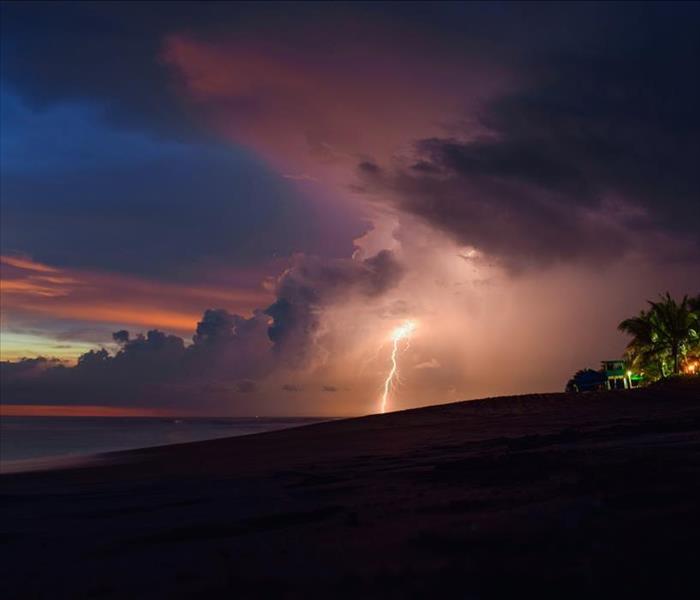 Did you know that there can be great variation in the severity of summer thunderstorms?
Did you know that there can be great variation in the severity of summer thunderstorms?
We see thunderstorms often during the summer months, as there is an increased risk of thunderstorms due to atmospheric conditions. All the while, there can be great variation in the severity of such storms. This blog, in conversation with data compiled by NOAA's National Severe Storms Laboratory, will dig into everything you need to know about different types of thunderstorms you may see during the summer, including what you should expect from them. Read on for an overview of various summer thunderstorm categories and the ways in which SERVPRO Disaster Recovery Team - Team Wall can help remedy any storm damage acquired by your home or commercial property in the aftermath of a storm.
Single-Cell Thunderstorm
It isn’t difficult to encounter a single-cell thunderstorm, especially on a hot summer afternoon. Single-cell storms are usually short and weak, typically concluding within an hour. Although they are short, they can still be powerful, as they often produce heavy rain and lightning.
Multi-Cell Thunderstorms
While single-cell thunderstorms are short storms, multi-cell thunderstorms can last much longer. Multi-cell thunderstorms are stronger than single-cell thunderstorms. These storms instead produce heavier rain, which may result in flooding, hail, strong winds, and even tornadoes.
Squall Line
A squall line consists of a line of thunderstorms, occurring one after the other. Like multi-cell thunderstorms, squall lines produce high winds and heavy rain, but they are less likely to initiate tornadoes and they generally pass over areas in a shorter amount of time. It is also possible to encounter a “super squall,” which can last longer.
Derecho
Have you ever experienced a derecho? It is an extremely rare weather event, characterized by a long, strong storm, featuring fast-moving thunderstorms and downpours, alongside strong winds. The destruction left behind from a derecho often resembles that of a tornado. All the while, it is important to remember that you are unlikely to encounter these kinds of storms frequently.
Have Storm Damage? SERVPRO Can Help
SERVPRO Disaster Recovery Team - Team Wall is here to help in the event that your home or business endures storm damage this summer as a result of any type of storm. Trust the skills and expertise of our highly-trained storm damage restoration technicians, who utilize advanced technology to provide customers with top-quality Storm Damage Restoration services. Find additional resources before help arrives on our SERVPRO of Harrisburg West website, like our Water and Storm Damage Tips page. You can also find information about the larger SERVPRO Disaster Recovery Team, which is made up of SERVPRO teams across the country and serves as a tool that allows us to compile resources in the event of large storm events. To learn more about how SERVPRO of Harrisburg West can make it “Like it never even happened” for your residential or commercial property, give us a call at (717) 510-6779.
Ready for Spring: Thunderstorm Preparation
3/17/2022 (Permalink)
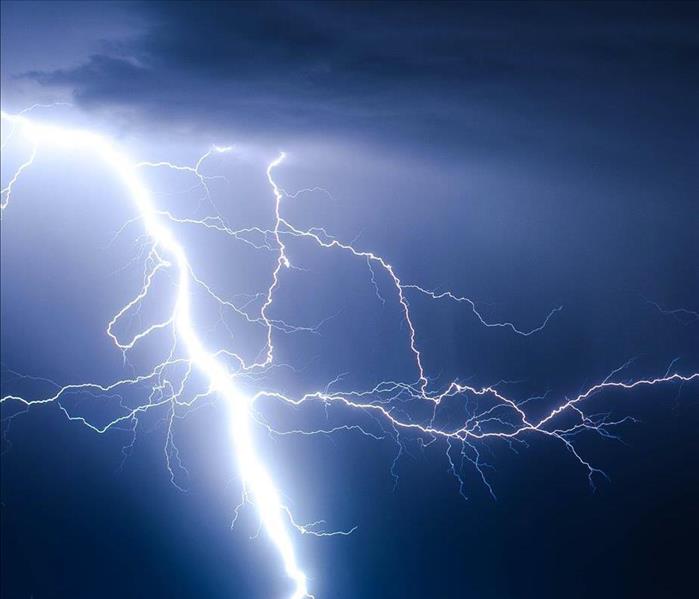 The American Red Cross verifies that the lightning produced by thunderstorms is more deadly than tornadoes and hurricanes.
The American Red Cross verifies that the lightning produced by thunderstorms is more deadly than tornadoes and hurricanes.
No two thunderstorms are alike but, in terms of their severity, all thunderstorms pose significant safety risks to residential and commercial properties. Oftentimes, lightning, downpours, hail, and high winds produced by thunderstorms result in flash flooding, as well as downed trees and powerlines. Statistically speaking, the American Red Cross verifies that the lightning produced by thunderstorms is more deadly than tornadoes and hurricanes. Due to these safety concerns, it is crucial that your home is prepared for anything. Keep reading to learn more about the actions that you can take to protect your home from destructive storm damage.
3 Thunderstorm Safety Tips
There are separate lists published by the American Red Cross of safety tips for before, during, and after thunderstorms. However, we would like to highlight a few of these tips that pertain specifically to preventing storm damage to residential properties. First, it is helpful to compile a list of outdoor items that should be brought indoors in the event of a thunderstorm. Large objects in your yard can be picked up off of the ground and jostled around by strong winds, threatening damage to your property if it comes into unwanted contact with your home. Additionally, doors and windows should be securely shut in the event of a thunderstorm in order to avoid the entrance of excess water and debris into your home. One way to protect windows is to install storm shutters. Finally, because thunderstorms frequently result in downed trees, be sure to trim trees and shrubbery back to the best of your ability before thunderstorms. This is beneficial in decreasing the possibility of branches falling and making unwanted contact with your property.
Call SERVPRO for Expert Storm Damage Restoration
Taking the storm safety precautions outlined above can help decrease the chances of your home sustaining damage after a thunderstorm but, ultimately, we can’t control the weather. All the while, unlike the weather, you can always trust and rely on SERVPRO Disaster Recovery Team - Team Wall for help in any emergency. It doesn’t matter where it takes place or how extensive the damage is- you can depend on SERVPRO’s expertise and 24-Hour Emergency services to make it “Like it never even happened.” For more information about our offerings, like our Commercial Storm Damage Restoration and the SERVPRO Disaster Recovery Team, check out the rest of our website.
Flooding From Snowmelt
2/4/2022 (Permalink)
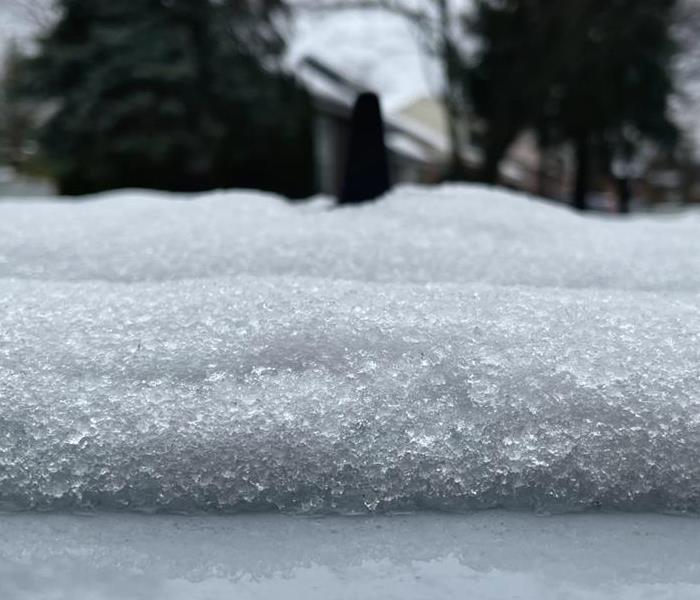 It is helpful to take preventative measures to protect your property from the dangers of flooding from melting snow.
It is helpful to take preventative measures to protect your property from the dangers of flooding from melting snow.
The Harrisburg area has seen a significant amount of snowfall already this year and it is likely that we will see a bit more before spring. Homes and businesses, therefore, can still be subject to flooding from snowmelt, so it is helpful to take preventative measures to protect your property from the dangers of flooding from melting snow, which can include hefty expenses for repairs, mold growth, and even structural complications. Continue reading to gain a deeper understanding of the causes and effects of flooding from snowmelt as well as the ways in which you can best protect your residential or commercial property from unwanted water damage.
What is a Snowmelt Flood?
A flood is categorized as a snowmelt flood when melting snow serves as the primary contributor to the water involved in the flooding, according to Weather.gov. In their Flooding Factsheet, Weather.gov highlights a difference between the saturation of rain into the ground and that of snow: Rain soaks into soil almost immediately upon impact, while snow takes longer to absorb into the ground because it must melt into water before it can enter the soil. If the moisture cannot be absorbed into the ground for whatever reason, it remains above ground, creating runoff, which often results in flooding. This is most common when the soil is already heavily saturated before the snow event, which can occur if the ground freezes or heavy rain or snow precedes the snow event. Weather.gov also states that snowmelt flooding happens every year in the United States and, in the 20th century, snowmelt contributed to eight of the most dangerous floods.
How Should You Prepare?
Moving the snow off of and away from your home or business is the first step to take in order to prevent water damage resulting from snowmelt flooding. Around the perimeter of your property, shovel snow at least 4-6 ft away from the structure. Additionally, be sure to safely remove snow from your roof if possible. You can also protect the inside of your property from flood damage by relocating valuable items or storing them in water-tight containers. Important items should be moved to areas of higher elevation that are less at risk of flooding as opposed to a basement or the ground-floor level of your property. Perhaps the most important action to take in order to protect your property is crafting an emergency plan for flooding or water damage. All it takes is one phone call to SERVPRO Disaster Recovery Team - Team Wall to initiate an effective emergency plan.
Experiencing Snowmelt Flooding? Call SERVPRO
Nothing is ever easy for homeowners and business owners alike when dealing with a flooding emergency. However, in the midst of all the stress, one thing can be easy: Picking up the phone and calling SERVPRO Disaster Recovery Team - Team Wall’s SERVPRO of Harrisburg West office at (717) 510-6779. No matter the time of day or the scope of your water damage, trust SERVPRO Team Wall’s experienced and expert water damage restoration technicians to restore your property to its preloss condition. More information about our Water Damage Restoration Services, offered to both residential and commercial properties, as well as our 24-Hour Emergency Services, our tried and true Water Damage Restoration Process, and our protocols for caring for your water damaged belongings, can all be found on our website.
Weird Weather Safety: Thundersnow
1/7/2022 (Permalink)
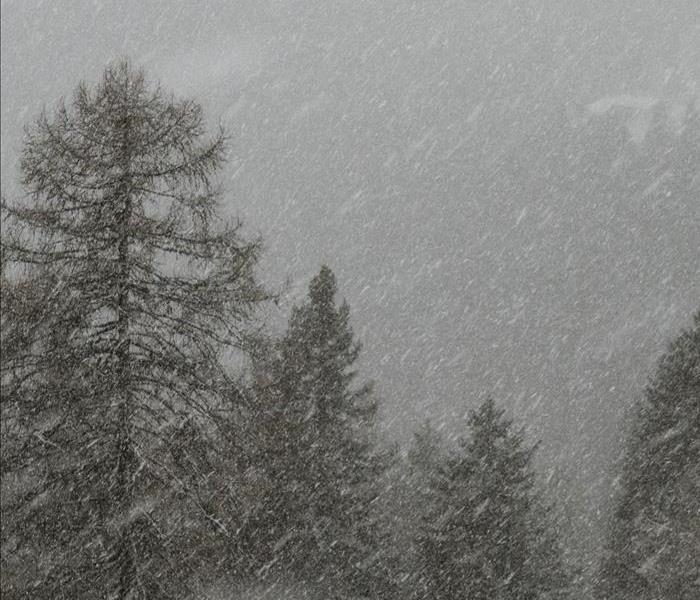 An uncommon winter weather event, this strange amalgamation of snow, lightning, and thunder does pop up in the atmosphere every once in a while.
An uncommon winter weather event, this strange amalgamation of snow, lightning, and thunder does pop up in the atmosphere every once in a while.
Thunderstorms often occur day-in and day-out during the spring and summer, but have you ever heard of thundersnow? It is an uncommon winter weather event, but such a strange amalgamation of snow, lightning, and thunder does pop up in the atmosphere every once in a while. Even though the year just began, our region has already experienced thundersnow. In this blog, you’ll learn about thundersnow, including what it is and why it happens, in addition to safety tips that will help keep you, your home or business, and others who live or work with you safe during a thundersnow event should one occur this winter.
What Is Thundersnow?
Instead of rain, which is the primary form of precipitation in a thunderstorm, snow is what falls to the ground in a thundersnow event. Thundersnow, according to the Farmer’s Almanac, is essentially a thunderstorm, as warm and cool air are colliding in the atmosphere, but due to colder temperatures during the winter, thundersnow, which features the combination of snow with thunder and lightning, occurs instead of a traditional thunderstorm. Thundersnow is not a common occurrence because this atmospheric temperature clash is unlikely to happen during the winter. However, severe winter weather events, like a Nor’easter that arrives on the heels of a slightly warmer cold front in our neck of the woods, may spur a thundersnow event.
Thundersnow Safety
The lightning and snow accumulation produced by thundersnow events risk safety concerns. Most of us are likely familiar with what to do to stay safe during a thunderstorm, but what should you do during a thundersnow event? Imposing all of the safety concerns presented by a normal thunderstorm in addition to all those threatened by a snowstorm, thundersnow should be taken seriously as a severe winter weather event. Be aware that your home or business may experience rapid snow accumulation on top of power outages resulting from strong winds and lightning strikes. It is critical to stay indoors and be prepared for a power outage during a thundersnow event, just as you would during a thunderstorm. Lastly, because thundersnow events are so rare, when they do hit, they often come as a surprise. Be on the lookout for thunder and lightning during your area’s next snowstorm and stay updated on the forecast in order to stay as safe as possible.
Trust SERVPRO’s Storm Damage Restoration Services
Whether it’s thundersnow, a thunderstorm, a snowstorm, or any other type of weather event, you can always rely on SERVPRO to make it “Like it never even happened,” in the event that a storm event causes damage to your property. SERVPRO Disaster Recovery Team - Team Wall’s Storm Damage Restoration and Commercial Storm Damage Restoration services will restore your property to its preloss condition. SERVPRO Disaster Recovery Team - Team Wall is a member of SERVPRO’s larger network of Disaster Recovery Teams, which connects us to numerous additional storm restoration resources and technology. Call SERVPRO of Harrisburg West immediately upon noticing storm damage at (717) 510-6779 for our rapid, 24 Hour Emergency Service to restore your property after any storm damage emergency.
Winter Storm Safety: Snow Squalls
11/12/2021 (Permalink)
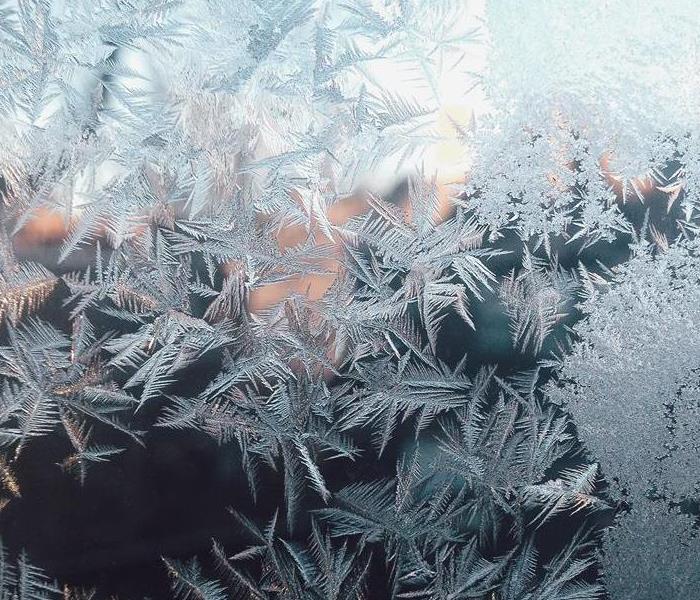 After a snow squall or any severe winter weather event, know that SERVPRO Disaster Recovery Team - Team Wall is just a call away.
After a snow squall or any severe winter weather event, know that SERVPRO Disaster Recovery Team - Team Wall is just a call away.
A snow squall is probably one of those weather-related terms that you have heard in forecasts and winter weather reports. However, many people don’t know what exactly a snow squall is, even if the term itself isn’t new. In this blog, we’ll learn more about snow squalls and the ways in which you can stay safe this winter in the event that you experience a snow squall.
What Is a Snow Squall?
A snow squall, according to the National Weather Service, is an “intense short-lived burst of heavy snowfall” that can last anywhere from a few minutes to half an hour. Gusty winds and limited visibility are just two of the dangers presented by snow squalls. You may experience just one snow squall or multiple squalls, one after another. They can occur during the day or at night. Snow squalls that occur at night often present a greater risk for danger, as visibility can become even more reduced without daylight. All the while, it is important to remember that snow squalls are infrequent winter weather events. The winter equivalent of a severe thunderstorm, snow squalls usually happen only once in a while.
Hazardous Driving Conditions
When a snow squall is forecasted, however, it can make for hazardous conditions on the road. Even though snow squalls may not leave significant accumulation of snow on the ground, they may still cause roads to freeze and create slippery conditions, which can lead to accidents. Sudden, blizzard-like conditions are not uncommon during snow squalls. In fact, the major difference between a snow squall and a blizzard is the time frame. Snow squalls are essentially blizzards squeezed into shorter segments.
Staying Safe During a Snow Squall
In order to stay safe this winter, you can take several precautions. Before hitting the road, check the forecast and listen to the radio for weather updates. If snow squalls or severe winter weather appear in the forecast and you are actively driving, be sure to pull over and stop driving as soon as possible before conditions become dangerous. To prevent accidents when driving in hazardous conditions, slow down, keep your headlights on, and avoid slamming your brakes.
SERVPRO Offers Professional Storm Damage Restoration Services
After a snow squall or any severe winter weather event, know that SERVPRO Disaster Recovery Team - Team Wall is just a call away. Our storm damage restoration professionals possess the experience, equipment, and knowledge to make your property’s winter storm damage “Like it never even happened.” Call SERVPRO of Harrisburg West at (717) 510-6779 for more information about the residential and commercial winter storm damage services that we offer year-round. Whether it’s a snow squall, a thunderstorm, or anything in-between, SERVPRO has your back any time of year.
Storm Safety: Generator Tips
9/30/2021 (Permalink)
 Infrequent usage can sometimes mean that our grasp on generator safety isn’t as strong as we might think.
Infrequent usage can sometimes mean that our grasp on generator safety isn’t as strong as we might think.
During or after a storm, generators often come to the rescue, restoring a sense of normalcy by restoring electricity. They facilitate a multitude of functions necessary for daily life when the power goes out, such as illuminating your home or business, making sure that your refrigerator stays cold, and charging your electronics. Power outages, thankfully, are not frequent occurrences. All the while, infrequent usage can sometimes mean that our grasp on generator safety isn’t as strong as we might think. Consumer Reports confirms that generators pose several safety concerns, ranging from carbon monoxide poisoning to fire hazards. There are a few steps that you can take in order to protect your home or business from these very dangerous generator usage outcomes. In this blog, we will share some of our top safety tips when it comes to generator usage during a power outage.
1. Keep Your Generator Outside
The risk of carbon monoxide poisoning can be increased when your generator is housed in any enclosed, indoor area, including basements and garages. According to the American Red Cross, it is beneficial to keep generators outdoors and as far away from doors and windows as possible, as placing your generator within close proximity of entrances to your home or business increases the chances of carbon monoxide making its way inside. Another helpful step is installing a carbon monoxide detector and alarm system inside of your home or business, which will alert those living or working inside of the property to exit as quickly as possible.
2. Store Fuel in a Safe Location
In order to power your home during a power outage, generators run on fuel. Before a storm, you may stock up on fuel. When it comes to storing generator fuel, it is best to keep it away from living spaces in areas that are cool, dry, and well-ventilated. Fuel can ignite quickly when it comes into contact with an item that instigates fire, but making sure that your generator fuel is being stored a safe distance away from such items can help reduce the chances of a fire igniting.
3. Consider Installing a Transfer Switch
Transfer switches can be a helpful tool in reducing the risk of an electrical fire when using a generator. Extension cords present a fire hazard and “backfeeding”, which occurs when you plug your generator directly into a wall outlet, can pose an increased threat of electrocution. A transfer switch eliminates the need for either, as it allows your generator to be plugged directly into your circuit panel, thereby reducing the risk of fire. Transfer switches sometimes also display wattage usage levels, helping you prevent your generator from overloading.
SERVPRO Is Standing By
A strong emphasis should be placed on caution in the event that you decide to power your residential or commercial business with a generator during a power outage. Make sure that you have a plan if a generator emergency, such as a fire igniting, occurs. A beneficial first step to take when disaster strikes is making a phone call to SERVPRO of Harrisburg West. If you discover fire damage resulting from your generator, call us at (717) 510-6779 and our team of fire damage restoration specialists will respond immediately. Learn more about our professional Storm Damage Restoration, Commercial Storm Damage Restoration, Fire Damage Restoration, and Commercial Fire Damage Restoration services. Trust SERVPRO, no matter what your emergency, to make it “Like it never even happened.”
What to Know About Lightning Damage This Summer
6/8/2021 (Permalink)
Summer storms are forceful aspects of nature that pose many risks to homes and businesses alike. Over the last few years, whenever summer rolls around, we post a blog or two about summer storm safety on various topics such as flash flooding damage and hurricane preparation in order to help homes and businesses alike to protect themselves from potential dangers presented by summer storms. When we discuss summer storm damage, we often think about water damage or physical damage to buildings due to debris and fallen trees, but lightning is another important factor that should be considered. Lightning can directly strike homes and commercial buildings that lack lightning protection, which can pose significant risks including fire damage and electrical power surges. Continue reading to learn more about the risks that lightning poses, as well as what you should do in the event that your home or business’ building endures lightning damage.
Types of Lightning Damage
When lightning hits a building, there is a chance that a fire can ignite. Usually, if a fire ignites, it will be in the attic or on the top floor of the building. Lightning adheres to electrical wires and circuits, which can then facilitate the spread of the fire throughout a home or commercial business building. If lightning makes direct contact with your home or building, its structure can be placed in jeopardy, as lightning can rip through roofs and attics, scorching its surroundings. Additionally, personal belongings can be damaged as a result of a lightning strike because lightning can send an electric surge throughout the structure that it hits. Electronics, including televisions, appliances, and computers, can undergo serious damage or destruction in this circumstance.
I Think That Lightning Struck My Building- What Should I Do?
If you think that there is a possibility that your home or business building has been struck by lightning, you may be wondering, “what should be my first step?” When lightning strikes a building, the resulting sound usually significantly overpowers that of thunder or distant lightning, making it easy to tell that a direct strike has occurred. Immediately check your home or business for fire and as soon as it is safe to do so, survey your roof for damage. Be sure to also check breakers and electrical outlets, as well as switches, in order to identify any electrical damage. Lastly, keep an eye out for leaks, which may indicate damage to piping.
SERVPRO Is Here to Help
In the event that you identify damage to your home or commercial business after enduring a direct lightning strike, call SERVPRO of Harrisburg West immediately at (717) 510-6779 (410) 229-0012 for professional Storm Damage Cleanup and Restoration Services that you can trust to make it “Like it never even happened.” We offer various storm damage restoration and remediation services that ensure our ability to cater to your home or business’ individual needs. Visit our website to learn more about our Commercial Storm Damage Restoration Services. If lightning led to the ignition of a fire, our Fire Damage Restoration Services have your back. If your roof has been damaged, look no further than our many Building Services, which include Roofing Services. No matter the scope of the damage that your home or commercial business experiences this summer, know that SERVPRO of Harrisburg West is prepared to help in any way we can.
Working Together to Restore Fort Sill
5/19/2021 (Permalink)
Everyday, the three locations of SERVPRO Team Wall coordinate and interact in some capacity, but it’s only every so often that we can show off the power of our combined resources. Joining forces with SERVPRO Team Bowen, Team Wall’s three offices made the trip to historic military base, Fort Sill, in Oklahoma for one of our biggest jobs to date. Oklahoma and Texas were hit hard by the March deep freeze and Fort Sill needed our help in restoring their facilities after experiencing about 200 burst pipes.
What Is Fort Sill?
Perched atop 94,000 acres, Fort Sill is a National Historic Landmark and the country’s largest field artillery complex. Since its completion in 1869, Fort Sill has seen the famous “Buffalo Soldiers” and other important figures in American history. It is also the burial place of Chiricahua Apache religious and military leader, Geronimo. While Fort Sill is a base for the U.S. Army, it also hosts the Marine Corps. Therefore, our ability to restore the historic Fort Sill this March meant a lot to those who live and work at the base, as well as our country.
Combining Our Resources
Considering that this was one of the largest projects that SERVPRO Team Wall has ever undertaken, we had all the more reason to celebrate our success in helping Fort Sill get back on its feet. Before beginning work, our team gauged the volume of moisture in about 110 buildings on the base through the use of moisture meters and thermal imaging cameras. About 50 of these buildings had endured at least one burst pipe. To get the job done in an efficient and timely manner, Team Wall’s three locations combined our resources. On any given day, anywhere from 70 to 100 crew members were supervised by eight crews. Crew supervisors were needed to oversee both the demolition and drying processes, as well as monitor the long list of equipment that we utilized. From small format equipment to four tractor trailers carrying about 1,000 air movers and 200 dehumidifiers, our team pulled out all the stops to return Fort Sill to its preloss condition. Our crews remained at Fort Sill for 17 days, busy providing climate control, descants, dehumidifiers, and temporary power to six separate buildings at the same time. Our team had a long list of tasks to complete and lots of hard work ahead, but it was nothing that the power of our three locations combined couldn’t handle.
Trust SERVPRO Team Wall’s 3 Locations for Your Storm Needs
As we alluded to earlier, our three locations work together on a daily basis, forming a tight-knit community that can come together to tackle any challenge that is thrown our way. Not every job is as large-scale as the Fort Sill restoration, but we practice cooperation and provide assistance to our other offices every day. In the event that a storm, large or small, hits your neighborhood, SERVPRO of Harrisburg West is ready to help. Backed by Team Wall’s two other locations in Hunt Valley and Harford County and Metro Pittsburgh East, we’re equipped with the tools required to combat emergencies of any size. Call us today at (717) 510-6779 and be sure to check out our website for more information about the professional Storm and Flood Services that we offer, in addition to our Water Restoration Process and Mold Remediation and Restoration services.
Our Guide to the Polar Vortex
3/24/2021 (Permalink)
Every winter, the phrase “polar vortex” means suiting up in our warmest winter coats, hats, and gloves. The Polar Vortex refers to a zone of cold air that gravitates toward the Earth’s two poles, according to the National Weather Service. We experience the Polar Vortex when that air takes a trip south during the winter, bringing us our own slice of Arctic air. It creates almost unbearable, cold conditions for us, risking such conditions as hypothermia, but it may come as a surprise to know that our homes and businesses can suffer just the same. Just as we need our heavy coats and cozy scarves, our homes and businesses need protecting from the cold.
Our homes and businesses can fall victim to freezing pipes and ice dams, which can both lead to serious water damage, during the polar vortex of the winter. The freezing, Arctic temperatures characteristic of the polar vortex can cause the water inside of pipes to freeze and expand, resulting in burst pipes. On the roof, when snow and ice accumulate, ridges of ice can form and block melting snow from leaving the roof. As a result, the water may leak down into the roof. Keep reading for our checklist of actions that you can take to protect your home or business from the potential dangers presented by the polar vortex.
Our Polar Vortex Survival Guide
For Ice Dams
- Clean snow off of your roof as soon as possible. However, be sure that you wait until the snow has stopped or there is a break in the storm. Before a snowstorm, it is helpful to remove any lingering snow or ice from a previous storm from the roof.
- Be sure that your attic or top floor is properly insulated before a storm. If your amount of insulation is lacking, it may be beneficial to add extra insulation.
For Freezing Pipes
- Before a storm, be sure that all pipes are insulated and any cracks that they may have are sealed.
- When temperatures drop, let your faucets drip in order to keep water flowing, which prevents the water from freezing.
- Maintain consistent, warm temperatures inside of your home or business. Additionally, make certain that your insulation is sufficient throughout the home or building
Trust SERVPRO This Winter
It’s impossible to predict exactly what will come our way this year, but regardless of what this year has in store, look no further than SERVPRO. If your home or business experiences water damage as a result of the polar vortex or harsh winter weather in general, our team of storm and water damage specialists can be trusted to provide water mitigation services that will get things back to normal in no time.
Winter Storm Uri
3/12/2021 (Permalink)
Ready for whatever happens ®
Winter Storm Uri did a number in the United States that spanned its wrath from coast to coast over a five-day stretch. 73% of the United States was covered in snow and the Plains/Midwest region of the nation witnessed record-breaking low temperatures and record-breaking damage, surpassing that of both Hurricane Ike and Harvey at a projected $195-$295 billion in damages and loss of economic output. These losses have been accredited to pipes bursting after the long freeze which Texas' infrastructure was not prepared to handle. SERVPRO Disaster Recovery Team – Team Wall is incredibly proud to be part of the response effort to more than 28,000 claims and counting. We have teams from our offices in Pittsburgh, Harrisburg, and Baltimore to support businesses and homeowners in Texas and Oklahoma. For more information on our current efforts and a firsthand look at the devastation, check out our social media accounts. We'll keep you updated.
The Phoenix Buildings: 2020 Q4 Job of the Quarter
1/18/2021 (Permalink)
Among the most powerful weather events, hurricanes stand out as some of the most intense. The unlucky towns and their residents are forced to endure an intense weather event that rocks their worlds, turning lives upside-down and leaving behind a path of unimaginable destruction.
Every year during hurricane season, SERVPRO makes trips to areas that have been the victims of hurricanes in order to provide our services to those in need. This year’s hurricane season was one for the history books and as a result, our team was completing storm work 24/7. For our “Job of the Quarter” during a quarter filled with a plethora of storm work, it makes perfect sense that the title should go to a job that we completed this September in the wake of Hurricane at the Phoenix Buildings in Orange Beach, Alabama.
Job of The Quarter
The “Job of the Quarter” is the job that best illustrates the finest characteristics of our SERVPRO team. The Phoenix Buildings job fits that description completely, as it displays SERVPRO Disaster Recovery Team Team Wall’s stellar turnaround time, coordination between each of our three offices, and our capability to be a “one-stop shop” for our customers.
Prior to Hurricane Sally in 2020, the last hurricane to make landfall in Alabama was Hurricane Ivan in 2004. Orange Beach was hit particularly hard and our team traveled there immediately after receiving the news from Storm Team Wilson concerning the storm damage at the Phoenix Buildings. Multiple stories of condos, which had all experienced significant water damage as a result of Hurricane Sally, we housed inside of the Phoenix Buildings. We began work on only one of the Phoenix Buildings initially, but after showcasing our strengths through our work on the first building, we were excited to be given the opportunity to work on a second.
The Phoenix Buildings job presented multiple challenges to our team, such as obtaining keys to individual condo units and completing work while residents were living in them. Hurricane Sally brought violent rain, which entered the condo units, from the top to the bottom of each building, via sliding glass doors. This storm was completely out of anyone’s control, which made it even more important to us that we completed our work as quickly as possible in order to restore a sense of normalcy in our customers’ lives during such a tumultuous time.
We knew that the only way to provide the speedy restoration that our customers deserved was to pull together SERVPRO Disaster Recovery Team Team Wall’s resources and flex our muscles. Here at SERVPRO, we are proud to be a “one-stop shop” for our customers by handling every service that they need, from the beginning to the end of the job. In order to do this, we compiled resources from our Hunt Valley, Harrisburg, and Pittsburgh offices. As a result, our team was able to complete work on both of the Phoenix Buildings in only two weeks, while our competitors working on some of the other Phoenix Buildings required the same amount of time to tackle only one building. SERVPRO offers many mitigation, restoration, and rebuild services so that we can save our customers time, money, and unnecessary hassle. From roofing services to document drying, we’re prepared to take care of our customers’ every concern after a destructive storm like Hurricane Sally.
Even though the relentless 2020 hurricane season is now behind us, we’re already beginning to prepare for this year’s hurricane season. While we’re hopeful that the 2021 hurricane season will give us slightly more room to breathe, we are excited about the opportunities that it will bring, like the Phoenix Buildings, that will allow us to help as many people as we can. No matter what 2021’s hurricane season has in store, we’ll be standing by, ready to help you or your client through whatever comes your way.
Running Towards the Storm
10/6/2020 (Permalink)
Have you ever felt that strange, eerie feeling of “what did I just miss?” Maybe it’s come to you when you’re cruising southbound on the highway, enjoying the fact that there’s no one around you, until you see traffic at a complete standstill in the northbound lanes.
We get that feeling pretty often here at SERVPRO, but we wouldn’t call it eerie. Instead, it’s just the nature of our job. When there’s a hurricane, flood, wildfire, or natural disaster, SERVPRO is on the road, driving toward the storm and getting ready to jump right in.
Is this an easy task? Not at all. One adjective that will never be used to describe our storm response work is “easy”. However, is it worth it? One thousand times yes.
Just this year alone, we’ve traveled to Cleveland, OH; Philadelphia, PA; Chicago, IL; Washington, DC; Saginaw, MI; Bear, DE; Cleveland, OH (again); and recently, Pensacola, FL and Orange Beach, AL to help homes and businesses. And we still have 3 months left in 2020.
The Vision Statement of Team Wall is to “Restore peace of mind to EVERY customer. EVERY day.” At home, this is always on our minds, but when we’re chasing a storm and preparing to help those in need, it takes on an entirely new meaning. No one has control over Mother Nature, and yet it has the power to turn people’s lives upside-down overnight. This is why we send our seasoned, professional team members to support those affected through every stage of the restoration process. We are our customers’ facilitator, advocating for them throughout the entire process, from demolition, to rebuild, to insurance coverage and approvals. Helping our customers through life-changing, momentous events is our job and it’s what we love most.
All of our team members currently responding to Hurricane Sally and helping those affected by the storm damage it’s left behind deserve a big shoutout. You are special people, your efforts are making a world of a difference, and we can’t begin to thank you enough!
Be Ready For Anything This Hurricane Season
8/7/2020 (Permalink)
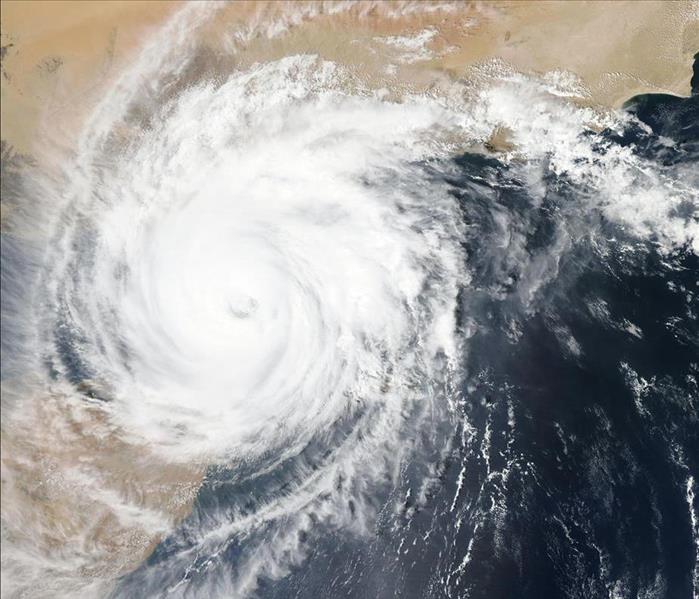 In the event that your business is hit with unexpected hurricane damage this hurricane season, SERVPRO is only a call away.
In the event that your business is hit with unexpected hurricane damage this hurricane season, SERVPRO is only a call away.
June 1st through November 30th is home to hurricane season in the United States. On the east coast specifically, the height of hurricane season usually occurs between August and October. With August quickly approaching and the number of named storms already uncharacteristically high this year, it’s time to get into gear for what could be a hurricane season that is 50% more severe than usual, according to a recent Colorado State University study. It is of the utmost importance that before a storm, commercial businesses develop an emergency plan in order to stay afloat after enduring a hurricane. Take these proactive steps to make sure that your commercial business is ready for anything this hurricane season.
Take Action Before The Storm
Important documents that house data essential to your business should be protected as best as possible in order to prevent them from becoming damaged during a hurricane emergency. Having information stored digitally, making copies, and placing physical documents in a waterproof container can help protect the information your business needs in order to operate. This hurricane season, many employees may still be working remotely. Therefore, it is especially important to have accurate contact information for every employee in order to get in touch and confirm their safety in case of an emergency. In terms of protecting your property, there are several steps you can take. To make sure that your roof is sturdy, have a professional inspect your roof so that any underlying issues can be dealt with prior to a storm. You can also purchase storm shutters to protect windows from debris and sandbags to minimize flooding around doors.
Have a Plan in Place
Protecting your physical workplace is critical to your business’ survival in the event of a hurricane. Having an emergency evacuation plan that details the safest stairwells and doorways to use will help employees know what to do if disaster strikes while at work. Familiarize employees with your business’ evacuation plan and create multiple copies of your business’ evacuation plan to post throughout the workplace in case employees need to be reminded during an emergency.
SERVPRO Is Here To Help
Even though taking the proactive actions listed above can help in limiting the damage your commercial business experiences during a hurricane, hurricanes can still bring unforeseen devastation. In the event that your business is hit with unexpected hurricane damage this hurricane season, SERVPRO is only a call away. Our team of storm damage professionals will arrive quickly, providing your commercial business with a thorough restoration.
Flash Floods: Know Your Risk
6/24/2020 (Permalink)
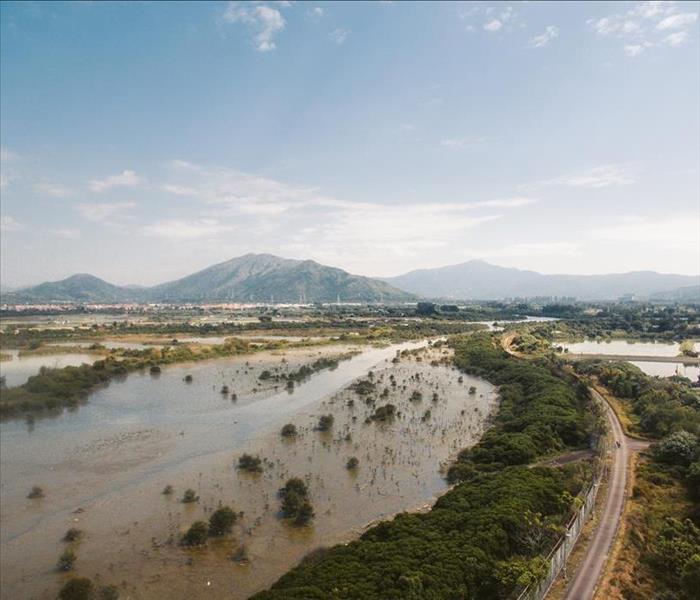 High intensity and duration of rainfall combine to form optimum conditions for flash flooding
High intensity and duration of rainfall combine to form optimum conditions for flash flooding
The roaring, fast-moving waters carried by flash floods can cause devastating damage to anything in its path, destroying roads, bridges, buildings, and even your home. Flash flooding is a type of rapid flooding that can occur at any time during the year, but is particularly common from early spring to late summer due to the slower jet stream and tendency for humidity during the season. According to NOAA, flooding is the number two weather-related killer in the United States, with an average of 81 deaths per year. Flash flooding poses even greater dangers due to the swift speed at which they develop combined with the overwhelming force of a flood. Therefore, it is important to develop a comprehensive understanding of the causes of flash flooding in order to know your risk and keep your home safe this summer.
Causes of Flash Flooding
During the summer the jet stream, which affects weather patterns, slows. As a result of the slower-moving jet stream, storms tend to remain in one area for an extended period of time. This causes the affected area to experience a significant amount of rainfall at once, therefore increasing the risk for flooding. Ultimately, high intensity and duration of rainfall combine to form optimum conditions for flash flooding. Several different weather scenarios can produce these optimum conditions for flash flooding, including slow-moving thunderstorms and hurricanes or other types of severe storms.
Additionally, topography plays an important role in the risk of flash flooding in an area. Proximity to bodies of water, such as rivers, lakes, or oceans, can increase the area’s risk for flash flooding, as they flood easily. Urban areas are also susceptible to flash flooding because they lack soil to absorb the water, resulting in floods developing quickly.
Know Your Risk
It is important to note that flash floods develop rapidly and as a result, you may not always receive warning before it hits. Flash floods can inflict water damage and even major structural damage on the home. For these reasons, it is crucial to know your area’s risk for flash flooding. If your area is at risk, consider creating an emergency flood kit and keep an eye out when storms are forecasted. Even if you are diligent, flash floods can still catch you off guard and cause devastating damage. Remember that SERVPRO and our team of storm damage experts have your back and will work hard to restore your home back to its condition before the flood.
3 Ways to Prevent Wind Damage Due to Spring Storms
3/16/2020 (Permalink)
As we transition from winter to spring, strong storms are beginning to become increasingly prevalent. These spring storms, which often carry severe thunderstorms, gusty winds, and sometimes even tornadoes, can wreak havoc on your home. Breaking tree branches and sending them flying across your yard, strong winds can pose an especially dangerous threat. The force of the wind in any given storm varies drastically, from calm speeds less than 1 mph to hurricane-force greater than or equal to 73 mph. During storms that produce strong winds, the areas of the home that are most commonly impacted are the roof, doors, windows, and garages, according to FEMA. These areas can become severely damaged due to strong winds, and your home’s structure can be compromised, which can require significant repairs. Taking preventative measures before a strong, spring storm even appears in the forecast can aid in protecting your home from wind damage this spring.
Maintain Landscape and Trees
The area surrounding your home plays a critical role in spring storms. Strong winds can break branches off of trees and can also result in fallen trees, which can cause devastating damage if the trees are situated close to your home. To prevent trees from falling during periods of strong wind, avoid over-watering trees, as doing so can weaken trees’ root systems. Because strong wind can also pick up objects, outdoor items such as patio furniture, grills, and sports equipment should be taken inside and stored in a safe place, such as a shed. If those items must remain outside during a storm, make sure that they are anchored to the ground as best as possible.
Inspect the Roof
It is often difficult to tell when our roofs are in need of repair because they lie outside of our sight. Because roofs can succumb to further damage during severe storms, it is imperative that roofs are inspected twice per year in order to identify and fix any major issues before a severe storm. Look for signs of roof damage, such as loose or missing shingles, as well as water damage in the attic. For a more thorough inspection of your roof, hire a roofing professional, as he or she could detect issues that are more difficult to spot. When shingles require replacement, it may be beneficial to switch to more durable, weather-resistant shingles in order to protect your roof from significant wind damage.
Reinforce Windows and Doors
Because doors and windows are vulnerable to destruction during storms with strong winds, installing storm shutters can be effective in protecting them from flying debris. You can purchase storm shutters or create your own by nailing plywood onto doors and windows during strong winds. Alongside doors and windows, garages are also particularly susceptible to damage during storms with strong winds. To protect your garage and keep it in place during a storm, consider purchasing a garage door bracing kit.
Preventing Basement Floods Due to Snowmelt
2/13/2020 (Permalink)
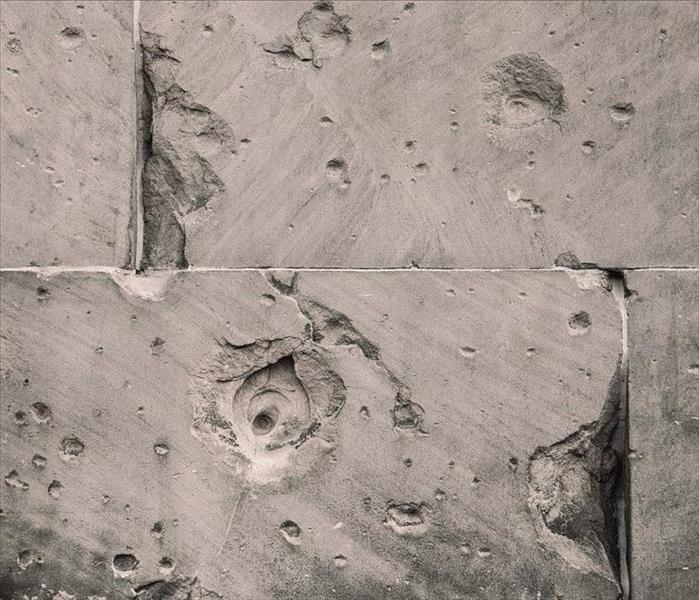 Water damage nearly always requires deep cleaning to prevent a multitude of issues.
Water damage nearly always requires deep cleaning to prevent a multitude of issues.
While basement flooding is prominent during rainy seasons, it should be known that basement flooding can occur at any time during the year. Basements, regardless of whether or not they have ever previously flooded, are capable of flooding. This is largely due to the fact that basements are usually located beneath ground level. Basement flooding occurs when moisture within the ground seeps through basement walls or foundation. Snow, ice, and other frozen precipitation is dumped on the ground during the winter season. When that precipitation melts, its moisture is absorbed into the ground, which can surround basement walls with water, increasing the likelihood of flooding. In order to protect your basement from flooding due to snow melt this winter and spring, consider removing snow and ensuring that basement foundations are free from any cracks.
Remove Snow
After a heavy snowfall, it is important to create a barrier of at least five feet between the snow and your home, as snow melt close to the home can increase the amount of moisture in the ground surrounding basement walls with moisture. Such a barrier can be created by shoveling snow away from the base of your home. Because snow that falls on roofs and overhangs can melt and fall around the base of the home, which would increase the amount of moisture in the ground surrounding the basement, it is also essential to clear snow off of those areas.
Fix Cracks in Foundation
When basement walls become cracked, the risk of flooding increases, as the cracks allow water in the ground to make its way into the basement. Flooding often leads to water damage, which can facilitate mold growth and damage objects such as walls, carpets, and furniture in a basement. Repairing these cracks is crucial in order to protect your basement from flooding due to snowmelt and all of its repercussions. For a temporary fix, cracks can be filled using epoxy. However, for a longer-lasting repair, enlisting the help of a professional may be beneficial. The chances of your basement flooding due to snowmelt can be decreased significantly if its foundation and walls are rid of any cracks.
If Your Basement Floods…
Even when one takes seemingly every preventative measure possible, there is still a chance that their basement can flood. In the event that your basement floods due to snowmelt, water needs to be removed as quickly as possible in order to avoid water damage. Minimal flooding may be able to be remedied through the utilization of a wet vacuum for water removal and dehumidifiers. Significant flooding, however, often requires professional restoration. Calling SERVPRO of Harrisburg West guarantees that your basement flood due to snowmelt will be remedied thoroughly and quickly in order to prevent any further damage.
Freezing Rain
11/20/2019 (Permalink)
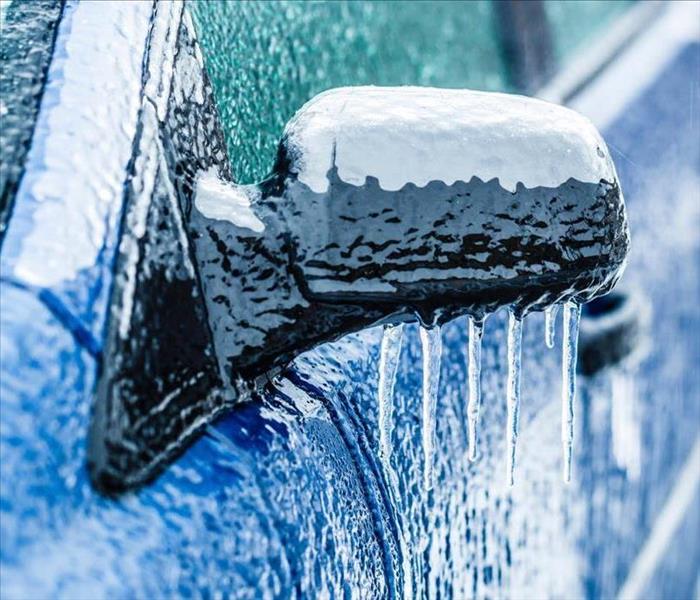 Frozen rain attached to a car
Frozen rain attached to a car
Due to the colder weather, the Harrisburg West area is beginning to experience its first freezes and views of snowfall of the season. This season is prime time for freezing rain due to cold ground temperatures. When the atmosphere is warm but the ground is cold, precipitation that falls as rain is likely to freeze when it comes into contact with freezing surfaces such as roadways, bridges, or sidewalks. When this happens, the liquid freezes into ice, which can be dangerous for drivers, pedestrians, and even power lines. In order to stay as safe as possible, understanding how to handle freezing rain and which precautions to take before the storm can be beneficial.
Other forms of winter precipitation, such as snow, are not incredibly difficult to deal with, as they can be eliminated through shoveling or melted with moderate sunlight. Freezing rain, on the other hand, produces ice, which requires a stronger method for elimination. The produced ice is not always visible, which poses a threat to drivers, who may perceive the ice simply as water on the road. Driving or walking on wet surfaces is also dangerous, but both are much more challenging tasks to complete on icy surfaces. The ice that forms as a result of freezing rain can also accumulate in heavy amounts on tree branches and power lines. If too much ice builds up on top of the branches or power lines, the weight of the ice can pull them down, causing fallen branches and power outages. Until the power lines are repaired, homes and businesses can be deprived of power and therefore, heat, for potentially extended periods of time. Heavy, falling branches can also put homes and businesses at an increased risk of damage.
Prior to a storm that is predicted to produce freezing rain, it is important to take precautions in order to reduce the amount of damage and disruption that the storm will have on your life. To reduce ice on your home or business’ sidewalks or driveways, purchase salt before the storm that you can sprinkle on freezing surfaces, as it will facilitate the process of melting the ice. Next, anticipate the possibility that damaged power lines from the storm may result in power outages, as well as the chance that ice produced by the storm will impede on your ability to safely leave your home. Stocking your home with essentials, including batteries, toilet paper, bottled water, blankets, and flashlights, is a good way to ensure that you will not need to leave your home in dangerous conditions.
Surviving Prolonged Power Outages
10/11/2019 (Permalink)
 Storm clouds above Carlisle
Storm clouds above Carlisle
Strong storms, which can shatter windows, bash power lines with fallen trees, and cause major flooding, put our homes’ electricity at risk. A power outage can last minutes, hours, or sometimes entire days if enough damage has been sustained. With electricity, we can heat or cool our homes and preserve the refrigerated food that we buy from the grocery store. When we lose power, everyday tasks, such as communicating and grocery shopping, become significantly more complicated. While waiting for the power to return, consider these tips in order to protect your family during a prolonged power outage.
Before the Losing Power
Having a fully-powered cellphone is of the utmost importance during an emergency, considering the inability to charge your phone. Keeping your cellphone use to a minimum will help to preserve the phone’s battery life. Writing down important numbers and addresses of local hospitals or storm shelters on paper is one way to limit cell phone use. For other electronic devices, such as flashlights and radios, keep back-up batteries. As power outages limit your ability to cook or preserve perishable food, be sure to stock cabinets with non-perishable foods such as granola bars or dried fruit. Lastly, if you have any medications that require refrigeration, have a back-up refrigeration plan in place beforehand.
During the Power Outage
While our first instinct after the power goes out may be to power essential electrical appliances with a generator, generators can be deadly is used improperly. As generators emit high concentration levels of carbon monoxide, keeping your generator outside of your home or garage is crucial. If any electrical appliances are not being powered by a generator, make sure that they are unplugged in order to protect them from damage resulting from power surges. Refrain from opening freezer or refrigerator doors, as without power, refrigerators will lose their cool temperatures within several hours and spoil the food inside. Finally, it is possible to cook perishable food on a gas stove, but gas stoves cannot be used to heat your home.
From ceiling leaks to larger scale water or storm damage, remember that SERVPRO is only a phone call away and ready to help restore your home after severe storms.
Hurricane Season: Are You Prepared?
9/3/2019 (Permalink)
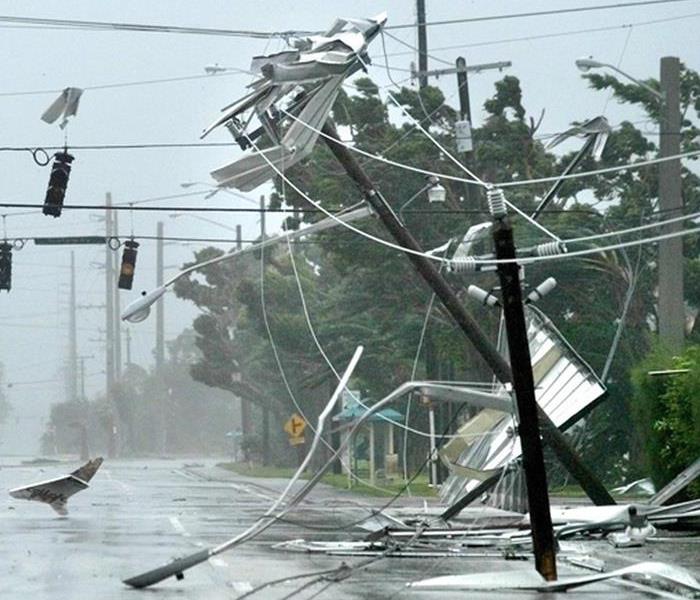 Hurricane Damage
Hurricane Damage
Hurricane Season: Are You Prepared?
Hurricane season is quickly approaching as we near the beginning of September, ushering in the possibility of violent winds and heavy rain wreaking havoc on your home. This time of year also marks National Preparedness Month, in which homeowners nation-wide are encouraged to prepare their homes for the wrath of hurricanes and other natural disasters. Inspecting your home’s exterior and taking precautions ahead of time is key in keeping your home as safe as possible during hurricane season.
Determining your home’s risk can help in estimating how hard your home would likely be hit by a hurricane. This can be calculated by taking the location of your home into consideration. Suppose your home is located in a coastal or low-lying area. In this case, your home would be at greater risk of flooding and it would be best to take extra safety measures. You should also have a thorough understanding of how much your homeowner’s insurance covers, as some policies neglect to cover flood damage or the cost to rebuild in the event of your home being destroyed.
Inspect your roof and gutters prior to the start of hurricane season. If the condition of your roof suffers due to loose or missing shingles, it will most likely have difficulty surviving in a hurricane. Replace missing or loose shingles and consider having your roof sealed as an extra precaution. If your gutters are clogged with debris, water will have a more difficult time draining. Clear debris from the gutters so that overflowing water will drain properly and not splash onto your roof, as this could damage the roof.
The chances of water entering your home are elevated due to major flooding produced by hurricanes. This water can damage floors, walls, carpets, and surrounding objects, so keeping water away from your home is important. Positioning sandbags in front of doors can prevent flood water from entering your home. Over time, weather can erode the sealing on your home’s windows, which can cause water to seep through the windows during storms. If your window seals are broken, call a professional to sufficiently seal your windows in time for hurricane season.
Owner’s Corner 3rd Quarter 2019
8/12/2019 (Permalink)
This time of year, the more than 1700 franchises from the United States, Canada, and even Puerto Rico assemble for SERVPRO’s annual convention. Joining together as one unit, we learned, networked, shared advice from experience, and listened to the stories of one another’s success in order to grow and promote SERVPRO’s strong reputation in the restoration business.
With this year being the 50th anniversary of the convention, the SERVPRO origin story was shared, detailing its creation in 1967 in Sacramento, California as well as its founders, Ted and Doris Isaacson. Learning about how the franchise was built from its roots to the $2.4 billion franchise system that it is today, was inspirational. It all started with the talented Isaacson couple, who handed the business to their children and allowed it to flourish.
Initially a painting business, Ted and Doris eventually shifted SERVPRO’s focus and decided to franchise it as a carpet and drapery cleaning company from there. Though the shifting and franchising process required plenty of work and hardship, it has ultimately paid off, as SERVPRO has expanded its impact internationally and now offers various restoration services beyond carpets and drapery cleaning, including general cleanup, reconstruction, and asbestos management services.
We can attest to SERVPRO’s dramatic change over the years, as Jim and I enjoyed our 10 year anniversary this May and much has changed since our time began. This change has been positive, as the franchise has strived to remain up to date in its ability to handle the changing expectations of customers in today’s market. This March, a surprising press release brought forth perhaps the most colossal changes:
By Jaewon Kang and Miriam Gottfried
March 18, 2019 3:12pm ET
Blackstone Group BX -0.11% ?? LP is nearing a deal to acquire cleaning- and emergency-restoration services provider SERVPRO Industries Inc. for more than $1 billion including debt, according to people familiar with the matter.
The private-equity has emerged as the winner in an auction for SERVPRO run by investment bank Harris Williams & Co., the people said.
SERVPRO, of Gallatin, Tenn., operates a network of more than 1,700 franchises that specializes in fire, water, mold and other cleanup services for residential and commercial customers. The closely held company was founded in 1967 by Doris Isaacson and her late husband, Ted Isaacson, as a painting business and is currently run by their eldest child, Susan Steen.
In light of Ted Isaacson’s passing in 2017, two out of the three Isaacson children decided to retire from leadership positions within SERVPRO in order to enjoy time with loved ones. Blackstone swung in from where the Isaacsons left off, generating mixed feelings from SERVPRO employees concerning the future of the franchise. However, after attending the convention and learning about Blackstone’s plans, we are optimistic and excited about what this new ownership will mean for Team Wall’s customers in the years to come.
Lastly, we would like to recognize the members of our team, stronger than 70 in number, and their achievements. Thanks to these achievements, our franchise was ranked in the top 20 out of all 1700 franchises for 2018, making this the fourth year in a row of achieving this recognition. This humbling accomplishment is all thanks to our team’s endless devotion to excellence. However, this wouldn’t be possible without our incredibly loyal and supportive customers who have trusted us over the years. Thank you so much!
We are so elated and optimistic about our future as a franchise and cannot wait to share this journey with all of you!
With thanks,
Jim and Trish Wall
Urban Flooding
7/22/2019 (Permalink)
As urban areas continue to develop across the country, the issue of urban flooding is becoming more relevant than ever before. Soil usually absorbs rain water, but as cities generally contain more concrete than soil, urban areas depend on a limited number of draining systems. These draining systems cause water to build up beneath city streets during heavy rainfall and therefore, cities tend to flood easily.
Flooding city streets and blocking roadways, urban flooding can have many consequences on daily life. Another example includes the phenomenon referred to as “dancing drain covers” in which the water that has built up in draining systems overflows, lifting drain covers off of the street surface. The covers, however, can shift their position in addition to lifting off of the ground, leaving large, dangerous openings in the street that could be treacherous for pedestrians that are crossing the street or cars that are driving over them.
Though urban flooding is not seen as serious safety concern in the public eye, its damage is often akin to that of flooding from hurricanes or the overflow of rivers if the city is hit with enough rain in a short amount of time. Keeping this in mind, it is crucial to identify and be conscious of the likelihood of flooding based on your city’s geography. If your city is located on a coast or situated by a major river, it is at a higher risk of flooding due to the potential for storm surge or high tide from a large body of water and the possibility of runoff from a river. If the risk of flooding is high in your city, it may be beneficial to put together a flood kit in the case of a flooding emergency. This kit could include extra food, water, batteries, and flashlights, among other emergency items that could prove to be helpful during a serious flood.
Surviving Summer Storms
7/15/2019 (Permalink)
Parts of Frederick, Maryland and the nation’s capital were slammed with thunderstorms carrying heavy rain over the course of this past 4th of July holiday weekend. Photos of vehicles underwater surfaced during the storm, illustrating flooded roadways and the severity of the flooding in the area. Even the basement of The White House began to flood, which can only mean that home and business owners in the area suffered an increased amount of damage. The reason as to why these heavy thunderstorms are so prevalent during the summer is the combination of atmospheric conditions that is commonly present during the summer months: moisture and rising warm air. This combination creates prime conditions for thunderstorms to form and it is important to understand what kind of damage summer thunderstorms can inflict upon your home or business.
Lightning
Thunderstorms often carry lightning, which can strike your home or business during a storm. Direct lightning strikes can lead to the ignition of electrical fires inside the building, tears in the roof and attic of the building, and the loss of shingles or gutters. If electrical appliances such as computers and refrigerators are plugged into outlets during a thunderstorm and lightning strikes the house, they can be harmed or possibly destroyed.
Flash Flooding
Thunderstorms can carry tremendous amounts of rain in addition to lightning, which can fall quickly and flood areas in its path. Sediment and mud can be carried by the flood water and therefore contaminate any objects with which it may come into contact inside of your home or business. If the flood water is not removed hastily, mold can grow and spread to other areas. It is helpful to understand the most common items damaged by flood water, including flooring, drywall, and carpet, in order to know where to look for water damage after a flood. Be sure to also check whether or not the flood water has shifted the building off of its structural foundation. If so, that can indicate that the building has suffered more serious damage.
How To Deal with the Damage
After the storm and once it is safe to enter areas that have flooded, look for any visible signs of lightning or water damage. Turn on light switches and check electrical breakers for functionality to find out if the building has endured any electrical damage. Keep an eye out for visible water damage on carpets, flooring, or walls and remove the water as soon as possible in order to protect them from the growth of mold. As you begin to remove water and clean up after the storm, turn off all water and electrical systems in order to prevent a reaction between water and electricity that could inflict further damage.
Flooding in Iowa
6/22/2019 (Permalink)
After 13 inches of rain fell over a 2-day period in Burlington, Iowa this May, SERVPRO crews traveled to the area in order to remediate the flooding. The storms resulted in much more than heavy rain, as large hail, high winds, and tornadoes swept through the area as well. The Missouri River flooded as well, which only added to the extensive flooding across the area. Since an unheard of 25 inches of snow fell in Des Moines, Iowa this February, the subsequent major snow melt restricted the ground from being able to absorb May’s inundation of rainfall. The rain water therefore spread across major roadways and flooded homes.
Approximately 30 job files were received by SERVPRO to remediate the flooding, so 3 crews were sent to do the job. Various types of damage can be caused to homes by flooding, including the contamination of drywall and the destruction of support beams. The flooding can even cause damage to the foundation of homes, which can be very serious. More specifically, flooding can also lead to wet finished basements as well as wet content, walls, and flooring. The probability of mold growth is increased during the first 24 hours after contamination. Therefore, restoration crews had to act fast.
The crews’ ability to help return the lives of those affected by the flooding back to normal motivated them to travel to Iowa, as it arose in them a certain feeling of satisfaction from being able to help so many people.
Broken Pipes in Chicago
6/22/2019 (Permalink)
SERVPRO crews traveled to Chicago, Illinois after five days of subzero temperatures hit the city in February. Aside from extremely low temperatures, the deep freeze also caused the Chicago River to completely freeze. Shortly afterward, temperatures soared from lows of -50 degrees to highs in the 30s, 40s, and even 50s. This resulted in broken pipes for hundreds of homeowners throughout the city. Although this is a common phenomenon during the winter, the extreme and rapid change in temperature elevated the occurrence of burst pipes for Chicago homeowners this year.
The negative temperatures caused pipes to freeze over, so when the temperature rose, the pipes thawed, burst, and resulted in flooding. This occurs when water inside the pipes expands, causing pressure to build inside of the pipes. Too much pressure causes the pipes to burst.
Burst pipes can cause flooding in basements as well as water damage to carpets and walls. Mold commonly grows in flood-damaged homes or damp areas, as the moisture allows for mold to grow and multiply.
To protect against mold, objects that cannot be cleaned, such as drywall or ceiling tiles, should be removed, while items such as glass or ceramic may be cleaned. Approximately 30 job files were received by SERVPRO and 3 crews were required to combat the issue. The excitement of preparing for such a restoration and traveling to a different part of the country motivated the crews to make the journey to Chicago and restore the homes of those affected by the burst pipes.





 24/7 Emergency Service
24/7 Emergency Service


















